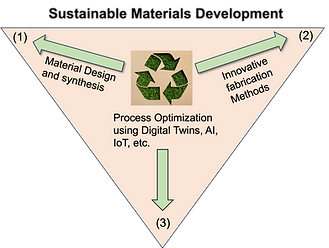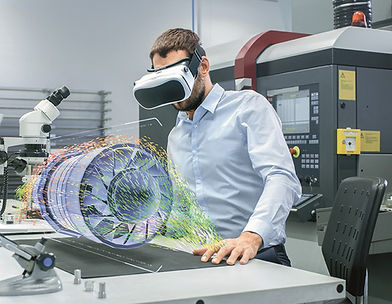
MULTIDISCIPLINARY RESEARCH
My work involves multidisciplinary research that cuts across different fields of science and engineering to create ground-breaking scientific discoveries. It involves the application of materials science, manufacturing engineering, computer science, mechanical engineering, petroleum engineering, and other fields to address the world's most pressing issues. My research centers around the use of computational modeling techniques to design and refine experiments related to roll-to-roll manufacturing, coreflooding, and electro-kinetics. This involves the development of multiphysics software for heat transfer analysis, flow through porous media, thermochemical reaction modeling, and fluid-structure interaction (FSI) in porous media. These software are designed using parallel algorithms capable of running on multiple CPUs and GPUs and thus portable on modern supercomputers. Experimentally, I also develop and manufacture sustainable bio-based nanocomposite materials. These renewable materials are also designed to have anti-bacterial properties and can thus protect against common food-borne diseases such as listeria, and E. coli.
SUSTAINABILITY
Sustainability is an important element of my research. This focus area helps to drive the discovery and innovation of new products that are sustainable and eco-friendly using green manufacturing methods. The development of sustainable materials requires the creation of materials that provide an adequate barrier against the influx of gases such as oxygen and water vapor, close to that of plastics. These materials are also designed to have the appropriate mechanical properties. This research also focuses on delivering effective decarbonization strategies for industrial heating and carbon storage. We also explore ways to better produce cleaner energy from sources such as geothermal energy.



COMPUTATIONAL FLUID DYNAMICS (CFD) AND AI
Computational Fluid Dynamics (CFD) is the application of numerical techniques for simulating problems related to fluids flowing through a domain. Such a methodology can be applied for scientific and engineering applications such as in hydrology, hydrogeology, petroleum engineering and other applications. My research focuses on the application of CFD in carrying out pore-scale modeling related to flow in porous media, multiphase flow, and fluid-structure interaction (FSI). Moreover, I develop models for investigating the interaction between multiphase fluids and non-linear deforming solid materials in the presence of varying hydrodynamic, chemical, and mechanical conditions by utilizing finite-volume and finite-element methods. I also explore the use of computational geometry from X-ray imaging. Digital rock physics is then applied to characterize the effective macroscale properties of the reconstructed 3D as seen below image. Artificial intelligence using convolutional neural network (CNN), multilayer perceptron (MLP) models, and generative adversarial networks (GAN) are also used as alternative means for obtaining these properties and for establishing process-structure-property relationships.
PORE-SCALE MODELING


-
Imaging of rocks is central to pore-scale physics efforts.
-
X-ray micro-computational tomography (CT) employed for imaging at high resolution.
-
2D images are reconstructed to form a 3D volume.
-
Images are ready for simulation after image processing.
RESEARCH LIST OF SELECTED PUBLICATIONS

RESEARCH LIST OF ALL PUBLICATIONS
PEER-REVIEWED JOURNAL PUBLICATIONS:

CONTACT US
Thanks for your interest in our research. Get in touch with us for any questions or comments regarding our work and publications. We’d love to hear from you.